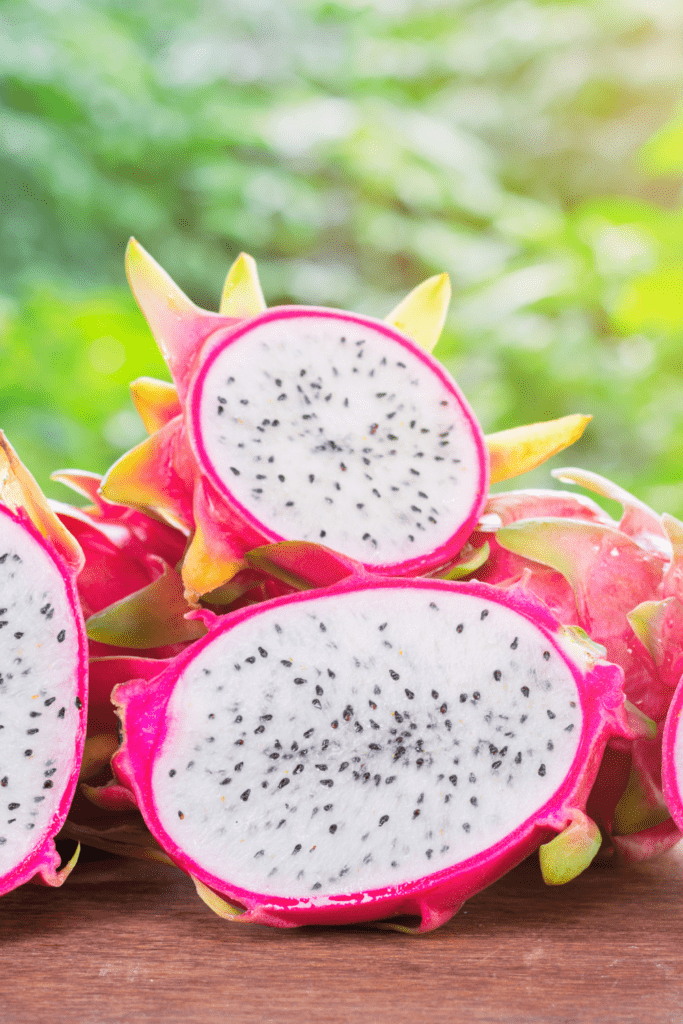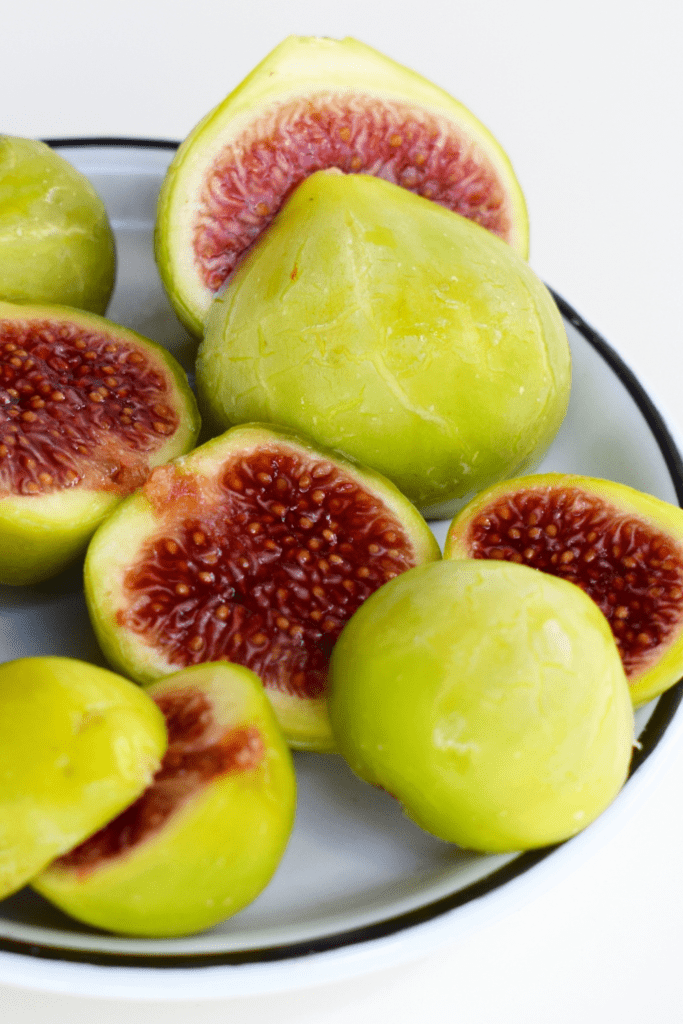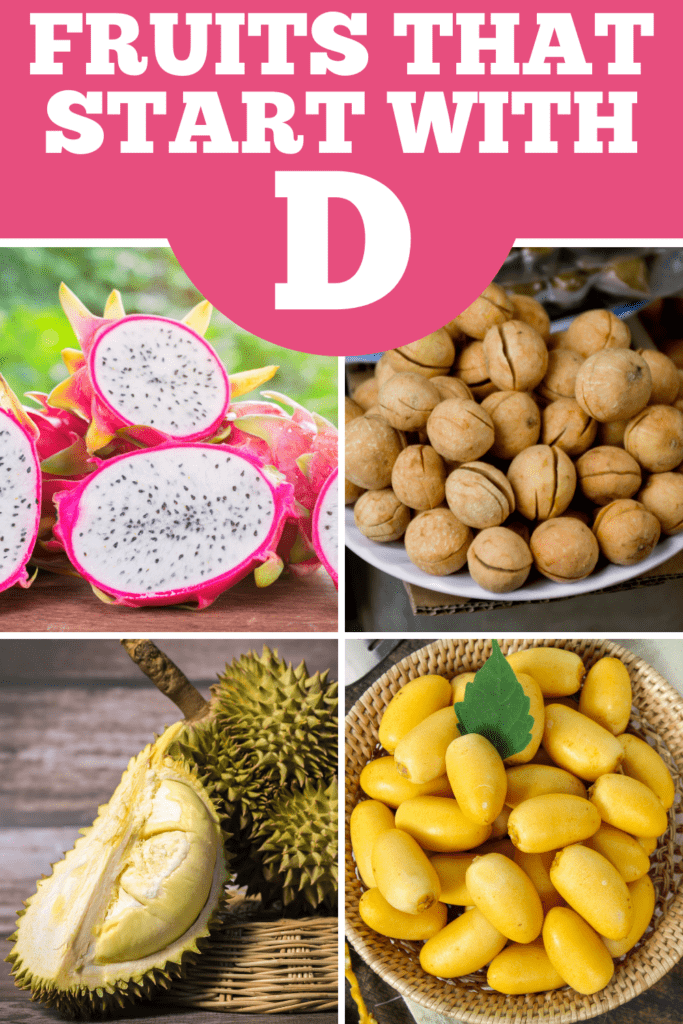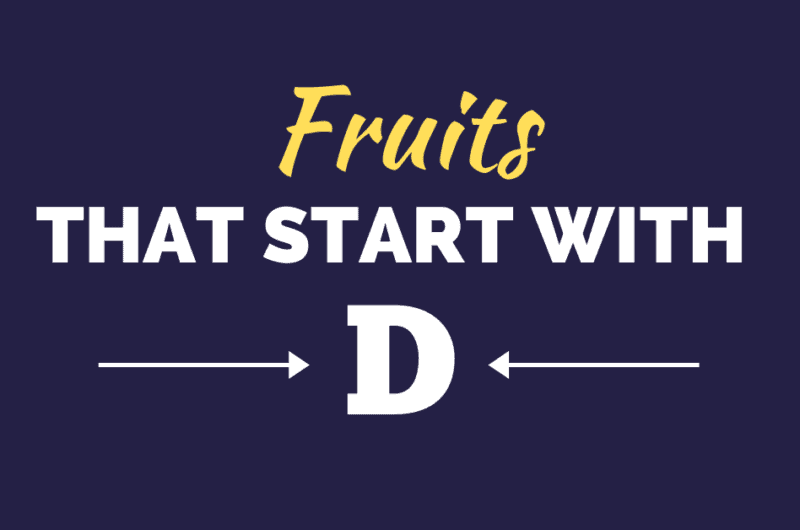Delicious, decadent, and delightful, this list of fruits that start with D will soon have you thinking of other D words. Like dessert. Or devour.
If your knowledge of fruits at this end of the alphabet starts and ends with dates, read on.
There are 20 different fruits here, ranging from the colorfully exotic (dragonfruit) to the strangely smelly (durian).
Things are about to get interesting as we dive into the diverse depths of the delectable D fruits (sorry, alliteration is addictive!)

1. Dates
Dates are nature’s candy, giving desserts like sticky toffee pudding their rich, fudgy flavor.
These chewy, intensely sweet treats are the fruit of the date palm tree which grows in tropical regions.
Dates are high in fiber and antioxidants, so don’t feel guilty about whipping them into homemade toffee sauce or wrapping them with bacon for a fancy snack.
These are the one of best natural sweeteners, beloved by health-conscious cooks.

2. Dragonfruit
Dragonfruit is the perfect produce for little eaters. Even the most fruit-averse kids will love dragonfruit’s fiery red/pink color and vivid green scales.
Split it open, and you’ll find white flesh dotted with black seeds. This pulp is sweet and crunchy with a subtle taste reminiscent of kiwis or pears.

3. Durian
Poor durian. This is the fruit widely known as, “that weird, smelly one.”
Durian is uniquely flavorful if you can get past the stench, which some describe as smelling of dirty gym socks, or rotting meat!
The hard, spiky shell contains a creamy custard-like flesh that tastes both savory and sweet.
Some love it, some hate it, but durian is a must for any foodie’s culinary bucket list.
Just don’t eat it on the Singapore Mass Transit system, where it’s apparently banned due to its overpowering stench.

4. Double Coconut
Also known as the sea coconut, double coconuts have the dubious honor of being the world’s largest seeds.
This giant fruit, which can weigh up to 55 lbs, is listed as an endangered species, so don’t expect to pick it up at your local grocery store any time soon.
It grows in the Seychelles, where it’s a common target for poachers thanks to its rarity.
5. Dead Man’s Fingers
Dead man’s fingers is about the most unappetizing name you can think of.
Sausage-shaped and an eye-catching blue, you can see where it comes from, but it’s still pretty gross.
The edible pulp is apparently tastier than the name suggests. Refreshing and delicately sweet, some liken it to a cucumber or melon.

6. Desert King Fig
This rich, delicious fruit looks like a strawberry on the inside with its bright red flesh.
Ripe in late summer, they grow mainly in the Pacific Northwest, but were first cultivated in California.
Like most varieties, the desert king fig is highly versatile. You can enjoy it raw as a snack straight from the tree or blend into pastes, jams, and baked goods.

7. Davidson’s Plum
Find a Davidson’s plum in the store, and it’s probably traveled all the way from Australia.
This nutritious plum contains 100 times the vitamin C as an orange, but don’t expect it to taste as sweet.
Acidic and tangy, the Davidson plum is a sour variety, so if you’re using it in recipes, be sure to add plenty of sweeteners.

8. Desert Lime
Desert limes are another Aussie fruit, growing from a wild shrub native to the Australia bush.
Ripe in early summer, this citrus fruit is bursting with zesty juice and an intense lime flavor.

9. Dewberries
Dewberries are related to blackberries, and there’s definitely a fruity family resemblance.
Dewberries are similar in taste and color to blackberries, but you can tell the difference from the way they grow.
If you’re foraging for dewberries, look down. These small, dark fruits appear on trailing vines, rather than upright shrubs.
10. Dodder-Laurel
Dodder-Laurel is a bit of a mouthful, so feel free to use this unique fruit’s amorous nickname – love vine.
Known as an aphrodisiac in Caribbean countries, the grape-like fruits ripen in spring but are not considered a commercial crop.
Instead, they’ve developed a reputation among natural healers as a tonic for romance and other ailments.

11. Duku Fruit
Native to Asia, the exotic duku fruit is similar to a lychee with its pearl-like flesh housed in a hard outer shell.
According to those in the know, duku taste like a cross between grapes and grapefruits – sweet, tart, and tangy.

12. Damson Plum
Sweet, dusky globes of goodness, damson plums have an intense flavor, making them perfect for jams and jellies.
Or you could just eat them straight from the tree for a fresh and nutritious late-summer snack.
13. Date Plum
Date plums are one of the sweetest varieties of the fruit.
A member of the persimmon family, they’re popular in the Black Sea region, where they find their way into desserts, jams, and pastries.
Either orange-yellow or brownish purple, date plums are picked when they’re at their soft, squidgy best, and can be eaten au natural (i.e. without peeling the skin).

14. Discovery Apple
They may not get as much love as Fiji, galas, or Granny Smiths, but discovery apples are delicious in their own right.
One of the earliest English varieties, they’re tangy and tart with a firm, crisp flesh.

15. Dekopon
Dekopons may sound like robot super-villains, but they’re actually a type of citrus fruit.
Yes, that’s a bit less exciting, but these Japanese mandarins are seedless, sweet, and easy to peel. They’re better than your average orange.
Also known as sumo citrus, they’re larger than normal mandarins and are easily identified, thanks to a telltale bump at the top.

16. Dabai Fruit
Dabai fruits grow from a tree commonly found in Borneo and look like very dark-colored grapes.
Raw dabai should be soaked in water before eating. Be warned – these are not your typical sweet fruit.
The taste is savory, salty, and tangy. Think olives mixed with strong cheese, and you’ll get the idea.
17. Darling Plum
The edible fruit of the darling plum tree grows in the tropics and subtropics, so if you’re heading to Florida or The Bahamas any time soon, keep an eye out.
These plums can be eaten raw or cooked and are said to taste like blueberries.

18. Dracontomelon
Fun to say and fun to eat, dracontomelons are a tropical treat with a tart taste.
Their sourness means dracontomelon aren’t usually eaten raw, but blended into sweet drinks or soaked in sugar syrup.

19. Desert Quandong
Bright red when ripe, the desert quandong is a striking, round fruit that’s high in vitamin C.
Also known as native peach, the taste is a tantalizing mix of apricots, rhubarb, and peaches.

20. Dangle Berry
Dangle berries (or blue huckleberries) are a dark blue berry loaded with antioxidants and vitamin A.
Get picking in late-summer or early fall to catch these berries at their best.
Use and enjoy as you would blueberries – in pies, crumbles, jams, or straight from the fruit bowl.











